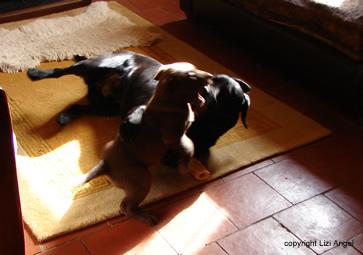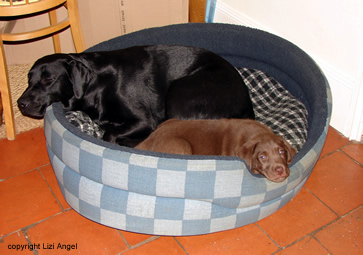PLAY

IS THE DOG A TRUE PACK ANIMAL?
Dogs naturally derive significant,
intrinsic pleasure from play and tend to form deep and lasting attachments
as the result of social exchanges that entice and sustain playful
interaction. Essentially, play is incompatible with social aversion
and mistrust, which means that creating the affectionate and trusting
bond that we try so hard to achieve with our dogs is easy ~ we just
need to play with them. |
||||||
| The idea that playing tug-o-war games and other potentially 'competitive' type play activities can cause any dog to become aggressive and dominant is extremely misleading and destructive, and the prohibitions against what are perceived as competitive play activities that are so frequently bandied in dog books and by many dog trainers are tailor-made to promote problems. In fact these dire warnings often have the effect of self-fulfilling prophecies, and by not engaging in tug games and rough and tumble type play activities, the very problems that owners seek to avoid are actually brought into being. It goes without saying that rough and tumble type play between dogs should be carefully monitored to ensure that the play remains fair and to prevent injury from knocks into furniture, etc, however, play between dogs, particularly young dogs, is usually fast and energetic with lots of growling, tooth snapping, jaw clashing, kicking and scrambling. |
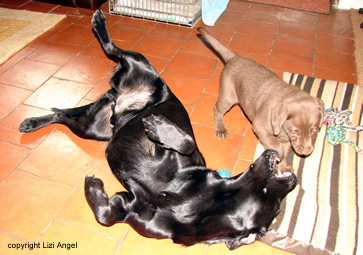 |
|||||
| The photo above right shows a well-mannered, year old, male Labrador enticing a 7 week old male Labrador puppy to play. The two dogs have only just met, and although the older dog is no threat to the puppy, the puppy approaches the invitation to play with caution. | ||||||
|
||||||
| Many owners hoping
to calm an excitable puppy are told to ignore it, or to reduce excessive
mouthing or biting to give it 'time-out', but the loss of this opportunity
for playful exchange at this tender age is not only a tremendous
shame, it is also confusing and socially isolating for the puppy.
Puppies learn to inhibit their bite through the very action and
consequence of biting their littermates too hard (i.e. the bitten
littermate squeals, and if the biting puppy persists, the littermate
bites back), which means that practices such as ignoring persistent
mouthing and 'time-out' rarely teach a puppy not to bite, or how
to limit its jaw pressure. 'Time-out', if not used appropriately
and responsibly, can actually cause psychological damage to some
puppies. Squealing like a hurt puppy when a puppy's teeth make even
the slightest contact with hands and clothes, is a much more effective
way to teach bite inhibition towards humans. |
||||||
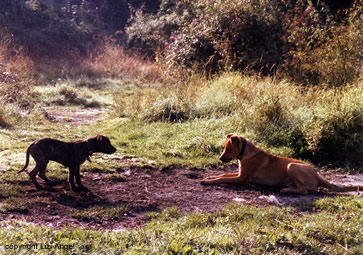 |
Puppies and older dogs alike appear
to be attuned to play as a way to enjoy and become familiar with
people and other dogs. The failure to engage in social play essentially
denies a dog access to the very sort of interaction needed to become
fully integrated into its social group. I often observe dogs responding
favourably to the wishes and commands of the children of the household,
whilst ignoring the adults who took them to puppy-training classes,
taught them basic obedience, and who walk and feed them. The reason
is simple ~ dogs form close bonds with playful people. The truth is that rough and tumble type play actually appears to enhance a dog’s ability to cope proactively with conflict situations and sudden changes that might otherwise result in more serious, reactive contests or behavioural extremes. In order to sustain play, players need to respect one another's limits and play fairly. Through the active process of play-fighting, dogs learn that to give advantage, as well as take it, ensures that the play not only continues, but that it continues to be playful. |
|||||
For the average dog, the benefits
of play for negotiating social harmony and mutual enjoyment far
outweigh any risks incurred by the activity, however, occasionally,
the normal partition that prevents play fighting and roughhousing
from escalating into earnest aggression may break down in certain
dogs, particularly certain fighting and guarding breeds. This is
because such dogs may be preemptively biased to respond to increased
competitive arousal and excitement by shifting from a play mode
into an attack mode. Whilst these dogs need very careful handling,
they still require suitable forms of structured, playful exchange
in order to develop trusting bonds with their owners. |
||||||
With most dogs, letting them ‘win’
at tug
games encourages them to continue playing because it’s
the social interaction that they want, not the tug toy. If the other
player is always ‘winning’ (i.e. taking), most dogs
will either lose interest in playing, or become more competitive.
From the dog’s point of view, players that always take aren’t more dominant or 'pack leaders', they’re just difficult to get on with. Faced with this apparent lack of a willingness to play fairly, some dogs will give up trying to interact with people altogether because whatever they try fails, whilst others, feeling frustrated, will try harder to get the attention and interaction that they crave. An essential quality of effective leadership is the power and freedom to instigate and sustain play, which requires a balance of give and take. Who would you rather follow ~ a taker or a giver? |
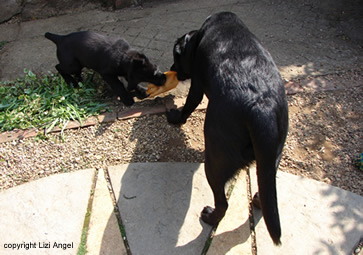 |
|||||
|
BACK TO TOP |
||||||
Copyright
Lizi Angel 2007-2020 |
||||||
